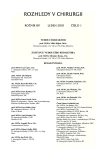Potential of Robot-assisted Vascular Surgery
Authors:
P. Štádler; L. Dvořáček; P. Vitásek; P. Matouš
Authors‘ workplace:
Oddělení cévní chirurgie, Nemocnice Na Homolce, Praha, prim. doc. MUDr. Petr Štádler, Ph. D.
Published in:
Rozhl. Chir., 2010, roč. 89, č. 1, s. 28-32.
Category:
Monothematic special - Original
Overview
Aim:
Based on experience with 150 robot-assissted vascular reconstructions, the authors discuss current potential applications of the Da Vinci robotic system in vascular surgery, as well as a potential for further use of this new technology in vascular surgery.
Material and Methodology:
In vascular surgery, laparoscopic methods have never been used as much as in general surgery. Although many studies presenting interesting outcomes have been published, laparoscopic vascular surgery has not been generally accepted. Its main problems include duration of the procedure and, in particular, the vascular staple size and associated difficulties with the vascular anastomosis suturing. However, recently, there have been many revolutionary advancements in medicine, including vascular surgery. Robot-assisted surgery is the next step in the development of miniinvasive methods. From November 2005 to August 2009, the authors performed 150 robot-assisted vascular reconstructions in the aorto-iliac region. Besides aorto-femoral reconstructions, the most significant procedures also included aortic aneurysm procedures, procedures on pelvic and splenic arteries, as well as hybrid procedures.
Results:
In four cases (2.7%) conversion to classical procedures were required and four subjects (2.7%) developed serious postoperative complications. In a single case (0.7%), the robotic apparatus had a defect during the procedure and the procedure was completed using laparoscopy. In a single case (0.7%), the procedure had to be cancelled because of an inoperable finding on the aorta. The average duration of the procedure in this study group was 228 minutes, the average time required for anastomosis suturing was 27 minutes and the average stapling time was 39 minutes.
Conclusion:
Robotic systems increase accuracy, control and quality of surgical procedures and offer higher quality surgery to patients. The authors managed to reach the world primacy in the field of vascular surgery and the Czech Republic has become a significant world leader in this superspecialized surgical specialty.
Key words:
laparoscopy – robotic surgery – Da Vinci system – minimally invasive methods in vascular surgery
Sources
1. Dion, Y. M., Katkhouda, N., Rouleau, C., Aucoin, A. Laparoscopy-assisted aortobifemoral bypass. Surg. Laparosc. Endosc., 1993 : 3: 425–429.
2. Barbera, L., Mumme, A., Metin, S., Zumtobel, V., Kemen, M. Operative results and outcome of twenty-four totally laparoscopic vascular procedures for aortoiliac occlusive disease. J. Vasc. Surg., 1998 : 1: 136–142.
3. Dostalík, J., Martínek, L., Chmelo, J. Aortobifemorální bypass laparoskopicky asistovaný. Rozhl. Chir., 1999 : 5: 214–217.
4. Matsumoto, Y., Nishimori, H., Yamada, H., Yamamoto, A., Okazaki, Y., Kusume, K., Hata, A., Toshimitsu, Y., Yamamoto, M., Sasaguri, S. Laparoscopy-assisted abdominal aortic aneurysm repair: first case reports from Japan. Circ. J., 2003 : 67 : 99–101.
5. Štádler, P., Špaček, M., Matouš, P., Vitásek, P., Kořisková, Z., Michálek, P. Laparoskopické cévní rekonstrukce – úvodní zkušenosti. Rozhl Chir., 2004 : 11 : 549–553.
6. Wisselink, W., Cuesta, M. A., Gracia, C., Rauwerda, J. A. Robot-assisted laparoscopic aortobifemoral bypass for aortoiliac occlusive disease: A report of two cases. J. Vasc. Surg., 2002 : 36 : 1079–1082.
7. Ruurda, J. P., Wisselink, W., Cuesta, M. A., Verhagen, H. J., Broeders, I. A. Robot-assisted versus standard videoscopic aortic replacement. A comparative study in pigs. Eur. J. Vasc. Endovasc. Surg., 2004 : 27 : 501–506.
8. Štádler, P., Matouš, P., Vitásek, P., Špaček, M. Robot-assisted aortoiliac reconstruction: A review of 30 cases. J. Vasc. Surg., 2006 : 44 : 915–919.
9. Štádler, P., Dvořáček, L., Vitásek, P., Matouš, P. Is Robotic Surgery Appropriate for Vascular Procedures? Report of 100 Aortoiliac Cases. Eur. J. Vasc. Endovasc. Surg., 2008 : 36 : 401–404.
10. Wisselink, W. Is robotic surgery right for vascular procedures? Report of 100 aortoiliac cases by Petr Stádler, et al. Eur. J. Vasc. Endovasc. Surg., 2008 : 36 : 405–406.
11. Štádler, P., Vitásek, P., Matouš, P., Dvořáček, L. Hybridní roboticky asistovaná operace, aortobifemorální bypass s rekonstrukcí kýly v jizvě. Rozhl. Chir., 2008 : 11 : 590–592.
12. Štádler, P., Šebesta, P., Vitásek, P., Matouš, P., El Samman, K. A modified technique of transperitoneal direct approach for totally laparoscopic aortoiliac surgery. Eur. J. Vasc. Endovasc. Surg., 2006 : 3: 266–269.
13. Ishikawa, N., Sun, Y. S., Nifong, L. W., Ohtake, H., Watanabe, G., Chitwood, W. R. Jr. Robotic replacement of the descending aorta in human cadaver. Artif. Organs., 2006 : 30 : 719-721.
15. Wahlgren, C. M., Skelly, C., Shalhav, A., Bassiouny, H. Hybrid laparorobotic debranching and endovascular repair of thoracoabdominal aortic aneurysm. Ann. Vasc. Surg., 2008 : 22 : 285–289.
16. Katz, M. R., Van, Praet, F., de Canniere, D., Murphy, D., Siwek, L., Seshadri-Kreaden, U., Friedrich, G., Bonatti, J. Integrated coronary revascularization: percutaneous coronary intervention plus robotic totally endoscopic coronary artery bypass. Circulation., 2006 : 114: (1 Suppl): I473–I476.
Labels
Surgery Orthopaedics Trauma surgeryArticle was published in
Perspectives in Surgery

2010 Issue 1
Most read in this issue
- Vascular Prostheses: 50 years of Advancement from Synthetic towards Tissue Engineering and Cell Therapy
- Successfully Combined Management of the Abberant Retroesophageal Arteria Subcalvia Dextra Aneurysm (arteria lusoria)
- Chronic Venous Insufficiency and Options for Modern Surgical Treatment within the Superficial System
- Pedal Bypass – Ten Years Experience
